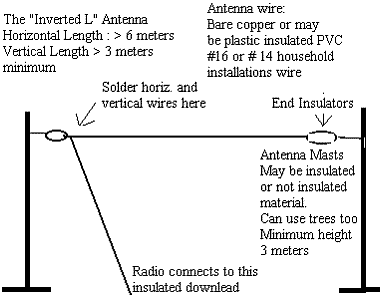|
The ever-popular
L-antenna
by Arnie
Coro, Radio Habana Cuba
Ever wanted
to install a shortwave receiving antenna fast?
I am almost sure that you will want to learn more about the "Inverted
L" antenna. About the easiest effective skywire to build ...
Just two
supports -- may be two masts, a mast and a tree, a mast and
a nearby building -- it need not be perfectly horizontal above
ground, as a matter of fact if the inverted "L" is installed in
a slightly tilted angle it seems to work better.
Although strictly speaking a true inverted L has the downlead
connected to one end of the horizontal section... my version calls
for connecting the downlead (a single wire) to a point about 20
percent from one end.
The antenna
should be connected to your receiver via an antenna tuner
with a real wide matching margin. For a 10 to 15 meter horizontal
section, strung between two masts of about 5 to 7 meters each,
you may expect very nice performance on frequencies extending
from about 3 to 30 MegaHertz.
Using the inverted "L" for transmitting, does require the installation
of a good ground system or a "floating counterpoise", a device
coming from the early days of radio that provides an amazing improvement
in performance of many antennas.
You may
want to build your inverted "L" with copper wire of no less
than no. 16 gauge. I prefer to use PVC covered copper wire of
no 16 or no 14, same type as used by electricians for home installations.
Overall
antenna length is not really critical, but the inverted "L"
does need have a horizontal section of no less than 5 to 7 meters
and a vertical section of no less than 3 to 5 meters to work effectively.
The most tested version here has a spacing between masts of 20
meters, a height above average terrain of no less than 5 meters
and I used a single wire floating counterpoise, installed below
the horizontal section of the antenna.

Do remember that in order to obtain optimum performance from
this very simple, yet effective, short wave antenna, you do need
to install it properly, solder the antenna downlead to the horizontal
section, and use an antenna
tuner.
|



